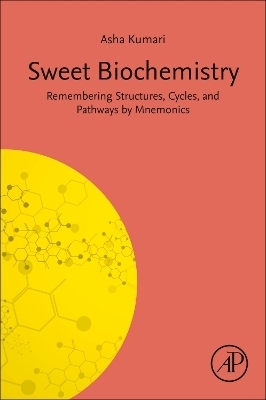
Sweet Biochemistry
Academic Press Inc (Verlag)
978-0-443-15348-8 (ISBN)
Dr. Asha Kumari is a young medical biochemist. Her parent institute is Pt. BD Sharma PGIMS, Rohtak, from where she completed her MBBS and MD in biochemistry in 2014. She is presently working as an assistant professor at the Department of Biochemistry, SHKM GMC, Nalhar, Nuh, Mewat, Haryana, India. She is a member of the Association of Medical Biochemists of India. She is actively involved in medical research and has written papers in international and national journals. Dr. Asha has a deep interest in improving the teaching methods in the medical field.
List of figures List of tables Preface Acknowledgements 1. Glycolysis Microview Importance of glucose phosphorylation Role of magnesium for kinases Critical isomerisation to fructose Second phosphorylation Reason of DHAP conversion to Gly-3-P? Conversion of Gly-3-P to 1,3-bisphosphoglycerate Reaction of phosphoglycerate kinase: the heroic step PG isomerises to 2-PG: the role Importance of enolase reaction 2. Citric acid cycle First have a look at the quick view of pathway Now let us observe the reactions in detail 3. Electron transport chain Microview The special electron transporters: NADH and FADH2 The story of electron transport chain What relates to electron transport chain in the story? 4. Beta oxidation of fatty acids Importance of beta oxidation of fatty acids Carnitine: prominent molecule of beta oxidation 5. Fatty acid biosynthesis Traditional recap Microview Relation of beta oxidation and synthesis of fatty acids synthesis 6. Cholesterol structure Role of cholesterol Lipid rafts and cholesterol What relates to cholesterol in honeycomb house? 7. Cholesterol synthesis Traditional recap Microview First enzyme thiolase 3-Hydroxy-3-methylglutaryl-CoA synthase 3-Hydroxy-3-methylglutaryl-CoA reductase Story of queen bee’s honeycomb house 8. Haem synthesis Rate-limiting step of haem synthesis: aminolevulinic acid formation Regulation of aminolevulinic acid synthase Aminolevulinic acid synthase activity in liver can be induced by steroids and some drugs by promoting ALAS1 gene expression 9. Porphyrias Traditional recap Manifestations of porphyria Why photosensitivity and neuropsychiatric symptoms are observed in porphyrias? Pain is reported by patients with porphyrias even within minutes of visible light or neon light exposure Neuropsychiatric features High ALAS1 activity may deplete pyridoxal phosphate, adding further to secondary sensory axonal neuropathy 10. Urea cycle Carbamoyl phosphate synthetase 1: an unique enzyme Are there other modulators also for carbamoyl phosphate synthetase 1? 11. Urea cycle disorders But why ammonia is so toxic to brain? 12. Glycogen storage disorders Glycogen storage diseases Mechanisms for features of glycogen storage disorders Story mnemonic of glycogen storage disorders 13. Mucopolysaccharidoses Hurler disease Scheie syndrome: Mucopolysaccharidoses I Hunter syndrome: Mucopolysaccharidoses II Sanfilippo syndrome: Mucopolysaccharidoses III Morquio syndrome: Mucopolysaccharidoses IV MaroteauxLamy syndrome: Mucopolysaccharidoses VI Sly syndrome: Mucopolysaccharidoses VII 14. Lipid storage disorders/sphingolipidoses Tay-Sach’s disease and Sandoff’s disease Gaucher disease NiemannPick disease Farber’s disease Fabry’s disease Metachromatic leukodystrophy 15. Ceramide structure and derivatives What are ceramides doing in our body 16. Prostaglandin synthesis Biological actions of prostaglandins Cyclooxygenase is the controller of rate-limiting step 17. Purine structure Chemically Here are some interesting purines 18. Purine synthesis de novo A brief view of reactions Amido phosphoribosyl transferase (Atase) rate-limiting enzyme with a unique ammonia channel Interesting regulation of purines 19. Pyrimidine structure-2 Uracil Thymine Cytosine 20. Pyrimidine de novo . 21. DNA structure and DNA replication Alternative DNA structures Here is a brief summary of steps of DNA replication 22. Differences in eukaryotic and prokaryotic replication 23. Transcription Let us see the steps of transcription 24. Translation Chain termination 25. Inhibitors of translation Antibiotics and the mechanism of action Toxins that disturb protein synthesis Lectins 26. Operon The lac Operon 27. Various types of RNA Messenger RNA Small-nuclear RNA MicroRNA Small-interfering RNA Ribozyme 28. Antibody 29. Class switching When is class switching required? Mechanism of class switching 30. Antigen Hapten Superantigens Neoantigens Autoantigen Adjuvants 31. Major histocompatibility complex The categorisation of human leucocyte antigen forms three classes I, II and III 32. Vaccines Whole pathogen vaccines Subunit vaccine Recombinant protein vaccine Toxoid vaccine Conjugate vaccine Virus-like particles Outer membrane vesicle vaccines Nucleic acid vaccines Viral-vectored vaccines Exercises Further reading Index
| Erscheinungsdatum | 26.07.2023 |
|---|---|
| Verlagsort | San Diego |
| Sprache | englisch |
| Maße | 152 x 229 mm |
| Gewicht | 450 g |
| Themenwelt | Naturwissenschaften ► Biologie ► Biochemie |
| Naturwissenschaften ► Physik / Astronomie ► Angewandte Physik | |
| ISBN-10 | 0-443-15348-5 / 0443153485 |
| ISBN-13 | 978-0-443-15348-8 / 9780443153488 |
| Zustand | Neuware |
| Haben Sie eine Frage zum Produkt? |
aus dem Bereich


